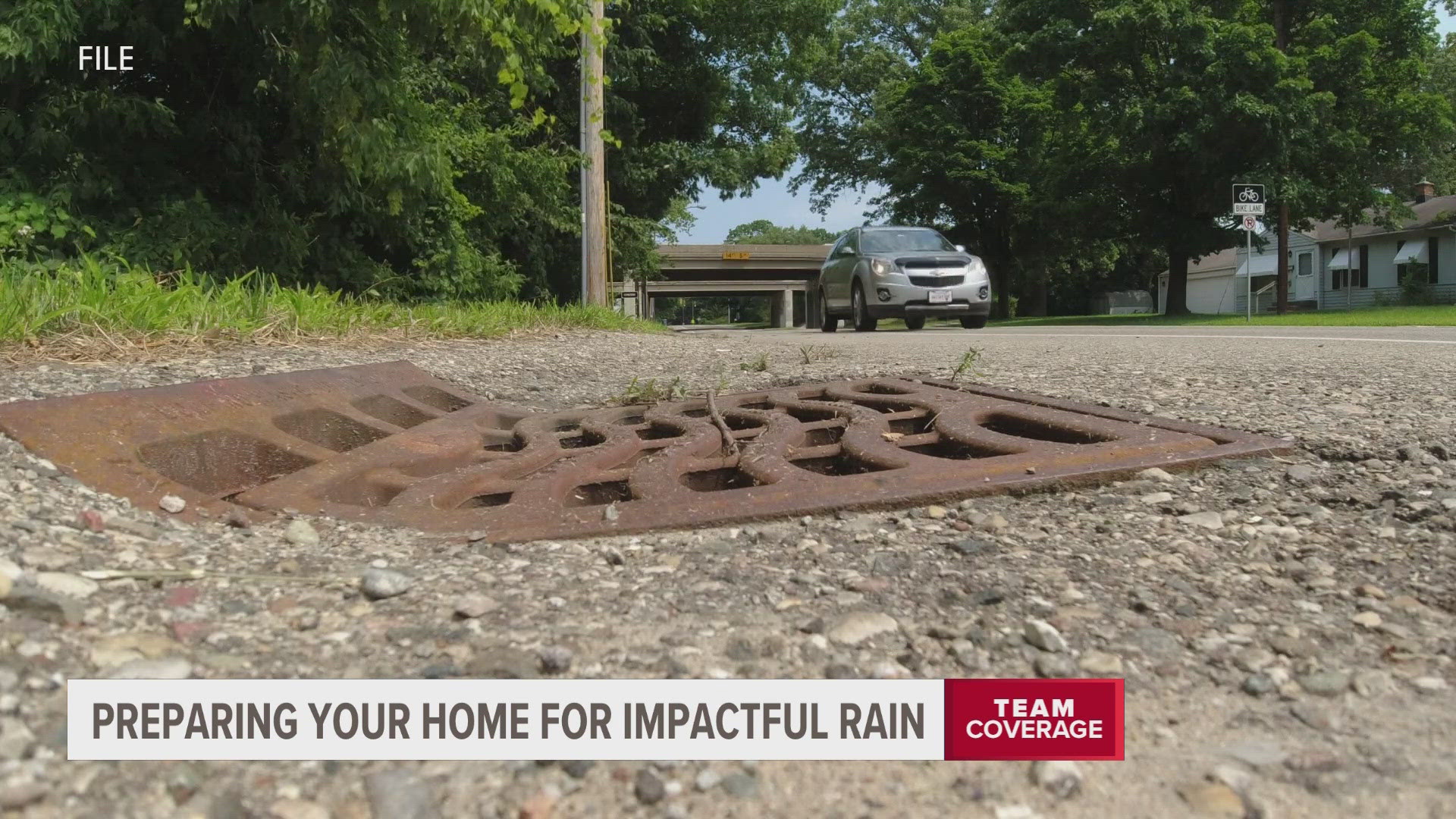GRAND RAPIDS, Mich. — With the remnants of Hurricane Beryl on its way to west Michigan, floods may follow. Experts say before the heavy rain hits, it's best to check if your home is up for the challenge.
According to 13 ON YOUR SIDE's weather team, Hurricane Beryl made landfall near Matagorda, Texas early Monday at Category 1 strength with winds up to 80 mph. As of early Tuesday, Beryl has weakened to a Tropical Depression as it treks over land, now positioned in Arkansas. Despite Beryl losing its tropical characteristics, it’ll continue to produce copious amounts of moisture in its associated swath of rain.
Most of Michigan is expected to get between 1 to 4 inches of rain across the state, with areas along the I-94 corridor expected to receive 4 to 6 inches or more. Those areas will have the highest chance of flooding.
The National Weather Service Grand Rapids office placed a large portion of the state under flood watch excluding areas like Muskegon, Newaygo and Oceana counties for expected lighter rainfall in those regions.
Storms are expected to hit Michigan late Tuesday into Wednesday morning.
With potential flooding on its way, experts in West Michigan said it is never a bad time to check if your home can withstand the water- with the multiple ways water can begin to pool up, experts said catching problems early can better prepare your home for weather events.
Grand Rapids city officials said they are completely confident in the city's infrastructure to handle whatever comes its way overnight.
"We have roughly 17,000 catch basins in the city of Grand Rapids," James Ouzts, the Environmental Services Manager for the city of Grand Rapids, said, "These are located in the curb gutters. Some are in alleys, some are in green spaces, and they take the water and they transport it through pipes, which eventually go to the Grand River."
Drains across the city manage most of the pooling up of water. However, as Ouzts said, the city can only check so many. With higher volumes of calls to the department, Ouzts said homeowners helping carry the workload can make the storm much more manageable.
"Homeowners can help us take care of these prior to a storm by making sure that any type of leaves or debris are removed from the catch basins surrounding the property," Ouzts said. "Once the debris gets wet, it blocks the water from passing through. If we can simply just take those leaves or grass clippings away prior to them getting wet, that allows the water to pass through and make it to the Grand River."
Ouzts said if a homeowner misses their window before the rain comes down, it's not too late to help."
"Go ahead and take an item like a shovel and clear the catch basin so that water can pass through," Ouzts said. "If it's beyond reachable by any type of tool, to the homeowner, they can always call 311."
"Our system is specifically designed to handle any type of flow that would come from a natural storm like this," Ouzts added.
When it comes to preparing for weather events, inside the home is no different than the outside. Brian Costello, the plumbing manager for Vredevoogd Heating and Cooling, said seasonal checks of essential plumbing infrastructure can further protect a homeowner from floods.
"Preventative maintenance is the best with any plumbing item in your house, any plumbing fixture in your house," Costello said. "Depending on how far that water will back up in your basement. It's possible. You can lose your furnace, you can lose your water heater, let alone all the valuables that you have inside your house."
Costello has been in the business for over 30 years. He said in his time, he's dealt with many different types of homes, and drainage systems. Most homes have a sump pump, according to Costello, but that may not be a fix-all.
"The most common type of thing that we see are some pump failures, which will lead to a basement flooding situation," Costello said. "There's no nowhere for the water to go, so it will simply back up into your house, and it will look like your pump is not pumping at all."
Costello said in the event of a backup, crews are able to drain the house, but finding the problem before it pops up, is always the better move.
"Preventative maintenance would be to do the bucket check on your sump pump," Costello said, "Grab a one-gallon bucket, two-gallon bucket, five-gallon bucket- fill it full of water in your sink bathtub simply pull it into the crock of your sump pump and see if your sump pump actually is operating and pumping properly."
"When the water doesn't go down in your crock," Costello added, "You know that something is wrong, and your sump pump is not working."
Costello said if something is wrong, contacting a professional is usually the best course of action. Catching the problem early will give crews enough time to fix the pump before the rain comes down.
If it's too late for preventative measures, Costello said, it's not too late to fix the problem for future downpours- working with remediation companies throughout the process.
"The quick fix is we evaluate, evaluate your pump and simply dump it out on a yard put 10 feet of piping out there to get that away from the house," Costello said. "We will work with remediation companies to actually physically come out and remediate the water that is in your home... we can come back and analyze what went wrong with your sump pump."
►Make it easy to keep up to date with more stories like this. Download the 13 ON YOUR SIDE app now.
Have a news tip? Email news@13onyourside.com, visit our Facebook page or Twitter. Subscribe to our YouTube channel.
Watch 13 ON YOUR SIDE for free on Roku, Amazon Fire TV Stick, Apple TV and on your phone.

